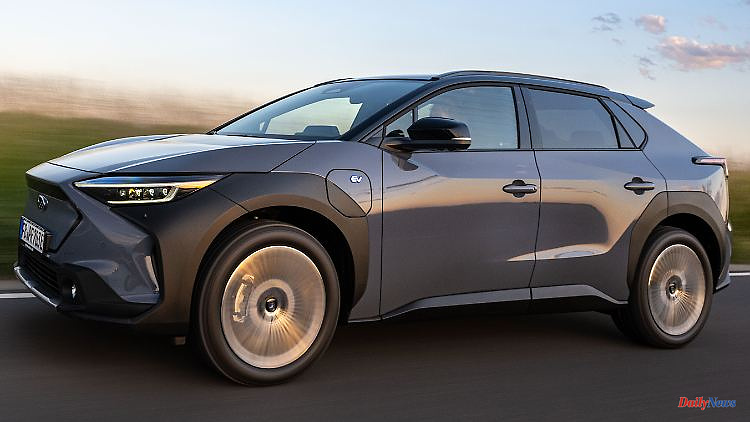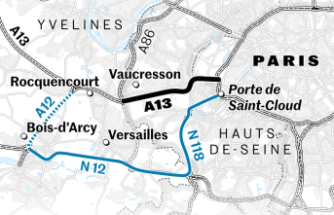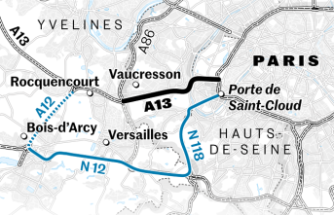If Toyota and Subaru enter the electric car business with a considerable delay, one should expect a big hit. But the practical test with the Solterra shows that this was unsuccessful, at least in one respect.
In 2022, almost every fifth newly registered car in Germany was an electric car. Stromer are now established and also a big business for the manufacturers. In this respect, it was high time for Subaru to also bring an electric model. Solterra is the name of this freshly launched, first full-electric vehicle from the manufacturer. The Japanese, by the way largely identical to the Toyota bZ4X, has become an imposing and visually attractive vehicle. But in one aspect that is very important for e-cars, the newcomer falls well short of expectations.
At 4.69 meters, the SUV crossover is about as long as a station wagon in the compact class, but at 1.65 meters it is significantly taller. Also thanks to powerful 20-inch wheels, plastic panels suggesting robustness and somewhat inharmonious proportions, the Subaru stands out noticeably from other cars in this class.
The massive exterior is not an empty promise, because the 450-liter trunk can be generously expanded thanks to a split folding rear seat backrest. How many liters fit in maximum, Subaru does not reveal. But the space is plentiful.
In any case, adults with outstretched legs can stretch out in the XL trunk. Alternatively, rear passengers sitting on the back seat enjoy plenty of knee room, especially since there is no cardan tunnel bulge restricting the footwell despite all-wheel drive. And the front seat is anything but cramped.
The cockpit offers an unusual mix of modern and classic furnishing elements. As is now customary, there is a large touchscreen in the center of the dashboard for the fast and fluid infotainment system. Looking over the steering wheel rim, one sees a small but informative color display, which brings driving-relevant details into the driver's field of vision in a similar way to a head-up display. But unlike many other manufacturers, the Solterra still offers all kinds of direct keys.
As a result, the workplace is not quite as tidy as is usual with e-vehicles today. The ergonomics, workmanship and material mix of the top-of-the-line equipment we tested, costing 61,000 euros, are well done. A price that does justice to the quality experience in the vehicle, although there are also finer interiors in this price range.
The Solterra also owes its price, which is not exactly small, to a powerful electric drive with two motors and a large battery. 71.4 kWh sounds like ample practical ranges, but this promise is not kept. Of course, the large, heavy, all-wheel drive and 160 kW/218 hp Subaru is not quite as efficient as a small electric car, which the official WLTP range of 416 kilometers for the Platinum Plus version we tested already indicates. But no matter how hard we tried, in practice we couldn't even begin to penetrate these range regions.
With a fully charged battery, the on-board computer showed a range of up to 390 kilometers when starting the journey. The air conditioning gave us the first range shock. If this is activated, more than 20 percent of the range vanishes into thin air at the push of a button, despite the heat pump. 390 became 290 kilometers in one fell swoop. Because we had a 300-kilometer motorway tour ahead of us, we switched off the air conditioning again when the outside temperature was 12 degrees. But even with a speed of 100 and in Eco mode, we only got 220 kilometers including a small safety buffer.
The lack of reliability of the prognosis was also disturbing. Air conditioning off, maximum 100 km/h, moderate outside temperatures - with other e-cars you can often get more out of it than initially calculated by the on-board computer. But here the opposite was the case. The next charging station stop was always forced to come much earlier than one might initially have hoped based on the first on-board computer calculations. In view of such a range degression, one would probably suspect a "hole in the tank" with a combustion engine.
We measured the lowest consumption value at around 24 kWh per 100 kilometers. If the travel speed is increased to a still moderate 120 km/h and the air conditioning is activated, consumption increases by 30 kWh. Even if you fill up with electricity at home at a reasonable price, 100 kilometers with the Solterra will cost over 10 euros. 15, 18 or more euros can also be incurred if you fill up at fast chargers along the motorway. It is currently cheaper to drive with a diesel.
The Solterra weighs well over two tons, which are powered by a twin-engine all-wheel drive. You shouldn't expect savings miracles for that reason alone. However, the driving pleasure remains manageable. The sprint to 100 km/h takes 6.9 seconds, but the maximum speed is only 160 km/h. At least with regard to the draft, you feel confident to some extent. In the electro scene, however, there are livelier contemporaries.
We experienced the standard all-wheel drive as pleasant, especially on wintry roads, because the so-called Grip Control takes away any fear of snow. Typical for the brand, there is no alternative to all-wheel drive, Subaru does not even offer a front-wheel drive variant, as offered by Toyota for its sister model.
However, the Japanese masters fast loading only partially convincingly. The best result was a charge from 10 to 80 percent on a 150 kW Hypercharger in 35 minutes, during which 44 kWh flowed into the batteries. The speed with alternating current is disappointing, because the on-board system currently allows a maximum of 7.4 kW.
The Solterra impresses positively with its equipment, which is already very extensive in the base, which costs 57,500 euros. If you add 3500 euros, you get full equipment. With eight airbags, adaptive cruise control, automatic air conditioning, heated seats, high-beam assistant, 360-degree camera system, electric tailgate, navigation system, charging cradle or the panoramic glass sunroof, the Subaru will also meet higher demands.
In addition, the vehicle looks solid, drives quietly, comfortably and, given the many assistance systems, almost by itself. Actually, the Solterra would be a perfect long-distance car. But instead of penetrating into contemporary range regions as an electric newcomer, the Subaru is unfortunately hopelessly behind even older electric models in this discipline.
Subaru Solterra - technical Daten












